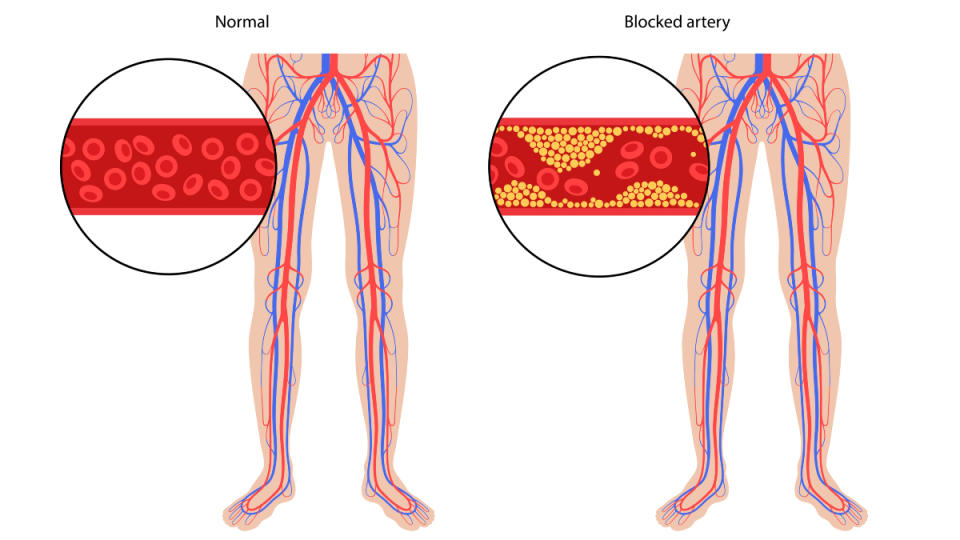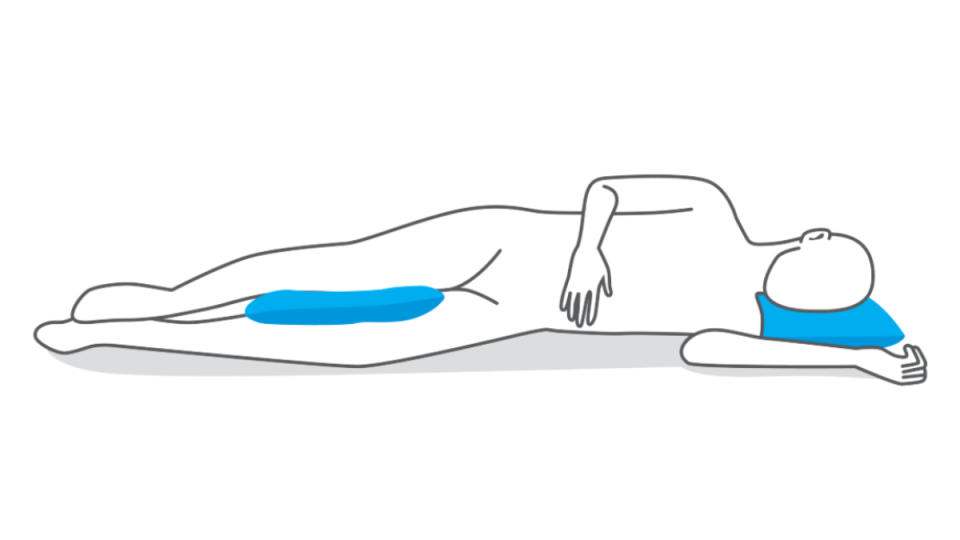Doctors Reveal the Best Sleeping Position to Outsmart Peripheral Artery Disease Leg Pain
If you suffer from peripheral artery disease (PAD) or other circulation problems, you know they're not just a pain during the day. The issue can often make it hard to sleep at night, too. And that may leave you wondering what the best sleeping position for peripheral artery disease is.
"With mild to moderate PAD, sometimes patients will have restless legs or get leg cramps when they're at rest," explains Payam Salehi, MD, Chief of Vascular Surgery at Tufts Medical Center in Boston. And certain sleeping positions can exacerbate the problem, leaving you tossing and turning at night, he adds.
The good news is that changing the way you lie down might be all it takes to snooze more soundly. If you're ready to kick those annoying leg cramps to the curb, see what experts have to say about the best sleeping position for peripheral artery disease, plus more easy ways to ease leg pain.
What is peripheral artery disease?
Peripheral artery disease is a condition where the vessels that carry blood from the heart to the legs and feet become narrow or blocked. "It inhibits circulation, so not enough blood gets down there," explains Joseph Ricotta, MD, National Medical Director for Vascular Surgery and Endovascular Therapy for Tenet Healthcare and a vascular surgeon at Delray Medical Center in Delray Beach, Florida.
PAD develops when fatty plaque builds up in the arteries. That can happen when a person has unmanaged high cholesterol, high blood pressure, diabetes or is a smoker, Dr. Ricotta explains.
What's more, everyone's risk for peripheral artery disease increases with time. "As we age, we develop more plaque deposits in our arteries," Dr. Salehi says. But the drop in estrogen that occurs during menopause can make women over 50 in particular more prone to PAD. The reason? The hormone helps your body's blood vessels stay more relaxed and open, say Yale researchers. When it dips, your odds of developing peripheral artery can disease increase.

Symptoms of peripheral artery disease
PAD is known for causing pain, aching, burning, fatigue and discomfort in your calves and feet. This stems from a lack of fresh blood and oxygen reaching your leg muscles, explains Dr. Ricotta. At first, the symptoms tend to strike after you've been walking or on your feet for a while. Then they gradually ease up with rest.
"As PAD progresses, however, symptoms get worse with less activity," Dr. Ricotta says. "So people get pain even when they're not walking, just when they're resting or sitting there." The result: Numbness, tingling or cramping when you're lying in bed, which can leave you restless and feeling zonked in the morning.
The best sleeping position for peripheral artery disease
Certain sleeping positions can add fuel to the PAD fire by further limiting blood flow to your lower extremities. So what's the best sleeping position for peripheral artery disease? Here's how the most common postures rank, from best to worst:
1. On your back
Back sleeping is the best position when you have peripheral artery disease, agree Dr. Ricotta and Dr. Salehi. "Your weight gets distributed evenly on your back, which decreases pressure on your blood vessels and increases blood flow to your limbs," Dr. Salehi explains.
Tucking a pillow or two under your legs and feet can help, too. While it won't boost blood flow down to your limbs, it'll help keep blood from pooling once it reaches your feet, which can also cause cramping and tingling. "The blood return to the heart is a little better when the legs are elevated," Dr. Salehi adds.
2. On your left side
Sleeping on your left side is the next best position when you have peripheral artery disease. On that side, "you're not putting any pressure on any internal organs, and you're again taking the pressure off of your blood vessels," says Dr. Ricotta. Sleeping on your right side, on the other hand, can compress major blood vessels like your aorta and vena cava. That can hamper blood flow and make symptoms worse.
Just make sure to keep your legs stacked on one another (tucking a pillow between your legs can help). Curling one leg under another "can interfere with blood flow to one leg, which can cause pain when it's done for a prolonged period of time," Dr. Salehi says.

3. On your stomach
Tend to be a belly sleeper? There's a good chance you'll feel better by banishing the habit, especially if you have PAD. "For any cardiovascular problem you shouldn't sleep on your stomach," Dr. Ricotta says. "It puts pressure on your heart, and that can cause blood not to flow as well."
More ways to ease peripheral artery disease symptoms
Beyond switching up your sleeping position, here are four more easy at-home options for soothing sore legs.
1. Slip on socks
If you're one of the nearly 50% of people with PAD who also have sleep apnea, a condition in which your breathing stops and starts overnight, talk with your doctor to make sure the sleep disorder is well-controlled. "Sleep apnea is not a cause of PAD, but it's associated with worsening PAD symptoms," Dr. Salehi says. Untreated sleep apnea puts you at risk for not getting enough oxygen in your blood while you sleep, which can worsen symptoms of leg cramping, he explains.
One easy trick that can help: Slipping on a pair of compression socks. A study in in Respiratory Physiology & Neurobiology found that wearing knee-high compression stockings during the daytime cuts sleep apnea symptoms by 36%. When you lie down at night, fluid that’s accumulated in legs and ankles flows out of your lower body and toward your neck. There, it swells tissues in the throat, triggering sleep apnea symptoms. But gently squeezing your legs during the day prevents pooling so you can snooze soundly. Plus the socks ease PAD itself, too! One to try: CEP Women's 3.0 Compression Socks (Buy from Amazon, $46.55).
2. Meander after meals
"We usually try to encourage patients to walk for 30 minutes at least three days a week," Dr. Ricotta says. Regular walking boosts the endurance of your leg muscles so they're less prone to pain and cramping, Dr. Salehi explains. It's also thought to stimulate the growth of healthy new blood vessels, which helps increase blood flow, according to Northwestern University research. Need a reminder to move? Try getting in the routine of going for a short stroll after lunch or dinner.

And if you're on a walk and your legs start to ache, "you can stop for a minute or two," Dr. Salehi says, but don't give up! Walking at a pace that makes your leg muscles temporarily uncomfortable (but not painful) will make them stronger and ultimately help you manage your symptoms, the Northwestern University study found. Think of it like a game of red light, green light. Walk until you'd uncomfortable, pause until the ache subsides, then resume your stroll. Over time, you'll be able to walk significantly further pain-free.
3. Set reminders to sip
Sounds simple, but keeping your fluid levels topped up helps ward off PAD symptoms. "Hydration is key when you have PAD," Dr. Ricotta says. "Being dehydrated makes your blood vessels contract and causes your blood to become thicker, which is worse for circulation." Try a free app like Water Reminder (for Apple) or Water Drink Reminder (for Android) to remind you to drink at least six 8-oz. glasses of water daily. Or click through to learn how a motivational water bottle can help.
Tip: If you're tired of water, try adding a glass of beet juice to the mix. The magenta sipper is packed with naturally occurring nitrates. These compounds relax blood vessels and help ease PAD-related leg cramps in as little as 59 seconds, a Duke University study found.
4. Give your calves a stretch
Next time your calves start to feel crampy or tight, give them a stretch. Try flexing your toes towards your legs for 10 to 20 seconds, then pointing your toes out for the same amount of time. Repeat two or three times total, recommends Dr. Salehi. "It may not be directly related to PAD, but certainly for your calf muscles, it reduces cramping and restlessness. Try to repeat it every day and work towards holding the stretch a little longer," he says.
For more ways to sleep soundly:
Too ‘Wired and Tired’ To Fall Asleep? MDs Explain Why It Happens — And the Easy Fixes
This ‘Music’ Switches Your Brain Into Deep Sleep Mode Automatically, Say Sleep Docs
This content is not a substitute for professional medical advice or diagnosis. Always consult your physician before pursuing any treatment plan.
Woman's World has affiliate partnerships. We receive compensation when you click on a link and make a purchase.
